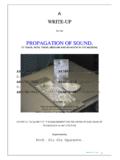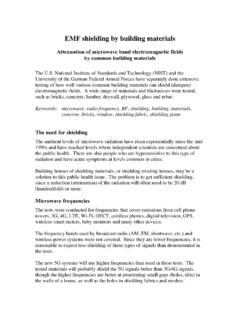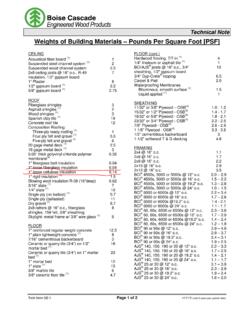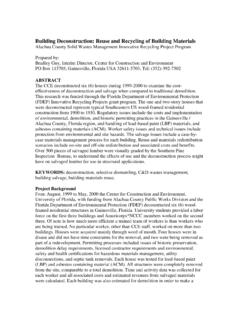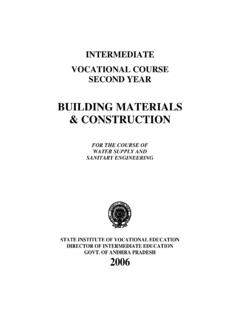Transcription of ACOUSTIC PROPERTIES OF BUILDING MATERIALS - …
1 A WRITE UP ON ACOUSTIC PROPERTIES OF BUILDING MATERIALS COMPILED BY ARC/01/9223 IJATUYI Olufunto T ARC/01/9246 OYEKU Mobolaji J. ARC/03/1930 ODUBENA Olawale O SUBMITTED IN PARTIAL FULFILLMENT OF THE REQUIREMENT FOR THE AWARD OF BACHELOR OF TECHNOLOGY IN ARCHITECTURE TO THE DEPARTMENT OF ARCHITECTURE SCHOOL OF ENVIRONMENTAL TECHNOLOGY FEDERAL UNIVERSITY OF TECHNOLOGY, AKURE Lecturer: Prof. Olu Ola Ogunsote APRIL 2007 TABLE OF CONTENT pages ABSRACT iii INTRODUCTION 1 BUILDING ACOUSTICS AND MATERIALS 2 ACOUSTIC PROPERTIES OF SPECIFIC BUILDING MATERIALS 4 Sound absorptive PROPERTIES
2 Of MATERIALS 4 Sound reflective PROPERTIES or transmission loss of MATERIALS 11 CONCLUSION 15 RECOMMENDATIONS 15 REFERENCES 15 ii ABSTRACT Acoustics in a higher citadel of learning, as a matter of fact as a course under the department of architecture is a necessity. This came to life with the need for students to understand the acoustics of spaces both interior and exterior, as well as to be able to design acoustically functional spaces that will enhance the intelligibility of sound or speech.
3 In addition to this, there is a rapid increase in loss of hearing caused by agents of hearing damage such as threshold shifts, sociocusis, due to an uncontrolled means of sound propagation. Hence, the need for the study of acoustics and infact the MATERIALS used to enhance it. iii INTRODUCTION What is acoustics? Acoustics is a term sometimes used for the science of sound in general. It is more commonly used for the special branch of that science, architectural acoustics, which deals with the construction of enclosed areas so as to enhance the hearing of speech or music. It could as well be regarded as the branch of architecture that deals with the control of sound which showcases the reflective, absorptive PROPERTIES of sound.
4 Acoustics is a subject that describes all aspects of sound and falls into the fields of both science and art. The science of sound envelops the technicalities of its generation, propagation and reception as well as objectively describing its qualities. In the artistic world, sound plays a large part in terms of the spoken word, music and other auditory experiences that give us pleasure. In most cases, the acoustics of a room will be satisfactory if a proper balance between sound-absorbing and sound-reflecting MATERIALS is created. In achieving this, reverberation as a factor should be taken into consideration. For modifying the reverberations, the architect has two types of MATERIALS , sound-absorbent and sound-reflecting, to coat the surfaces of ceilings, walls, and floors.
5 Soft MATERIALS such as cork and felt absorb most of the sound that strikes them, although they may reflect some of the low-frequency sounds. Hard MATERIALS such as stone and metals reflect most of the sound that strikes them. The acoustics of a large auditorium may be very different when it is full from when it is empty; empty seats reflect sound, whereas an audience absorbs sound. Hence, a study of the ACOUSTIC PROPERTIES of various BUILDING MATERIALS in order to broaden the scope of the students of architecture and to facilitate the selection of quality MATERIALS that will ensure good acoustics all round a space is needed. It should however be noted that there are various MATERIALS used to achieve a good ACOUSTIC in construction, but for the purpose of this analysis, few number of MATERIALS will be mentioned.
6 1 Aims and objectives The study of the ACOUSTIC PROPERTIES of various BUILDING MATERIALS is to achieve the following objective; 1. To ascertain precisely, the type of material that will be used to achieve a particular sound level within a space. 2. To broaden the scope of the student in the field of acoustics. 3. To help in determining the various uses of different MATERIALS . 4. To be able to analyze the acoustics of buildings. 5. To know the wide varieties of MATERIALS that is available for the said purpose. 6. To be able to solve the problem of acoustics within an interior space as well as the exterior space. BUILDING ACOUSTICS AND MATERIALS Noise control as the name suggests, envelops the techniques used to minimize the effects of unwanted sound and thus optimize environmental conditions.
7 In the construction industry, BUILDING Acoustics is the term which covers this aspect of sound. BUILDING Acoustics involves both the control of noise within an enclosed space and the reduction of noise between rooms or from either outside or inside a BUILDING . BUILDING material is any one of various substances out of which buildings are constructed. They come in different forms and are also applied in various ways in BUILDING . MATERIALS in BUILDING construction for the purpose of this write-up will be classified under the four major component parts of a BUILDING . This includes the following; 1. walls 2. floors 3. ceilings 4. roofs 2 Components Of BUILDING And Their MATERIALS 1.
8 WALLS: This is regarded as flat side of BUILDING or room, a vertical structure forming an inside partition or an outside surface of a BUILDING . It can as well be seen as a standing structure that surrounds or blocks, a narrow upright structure, usually built of stone, wood, plaster, or brick, which acts as a boundary or keeps something in or out. Other MATERIALS used in wall construction include, Glass (as curtain walls), Sandcrete blocks, Plastics, Tiles (mosaic) 2. FLOORS: It is a part of room to walk on: the flat horizontal part of a room on which people walk. The material used in construction include, Timber or wood, Concrete, Tiles, Stones 3.
9 CEILINGS: It is seen as the inside top of room: the overhead surface of a room, or the material used to line this surface. The overhead surface of a room, opposite the floor. Usually the term refers to a flat, beamed, or curved surface that conceals the underside of the roof or the floor above, but it may also refer generally to the exposed underside. There are several MATERIALS used for this purpose and they include, Asbestos ceiling boards, Celotex boards, Timber panels, Plaster of Paris ( ) ACOUSTIC boards 3. ROOFS: It is the upper covering of BUILDING : the outside covering of the top of a BUILDING , or the framework supporting this. They are made of MATERIALS such as.
10 Plastics (acrylics), Aluminium Sheets, Clay tiles, Asbestos 3 ACOUSTIC PROPERTIES OF SPECIFIC BUILDING MATERIALS It is very important to distinguish between sound absorption and sound transmission loss. Sound absorbing MATERIALS control sound within spaces and function by allowing sound to pass through them relatively easily. They are generally porous and absorb sound as a result of many interactions. Conversely, a material or system, that provides a good sound transmission loss is usually non-porous and a good reflector of sound. SOUND ABSORPTIVE PROPERTIES OF MATERIALS Noise is generally controlled within a space using sound absorbing MATERIALS .
